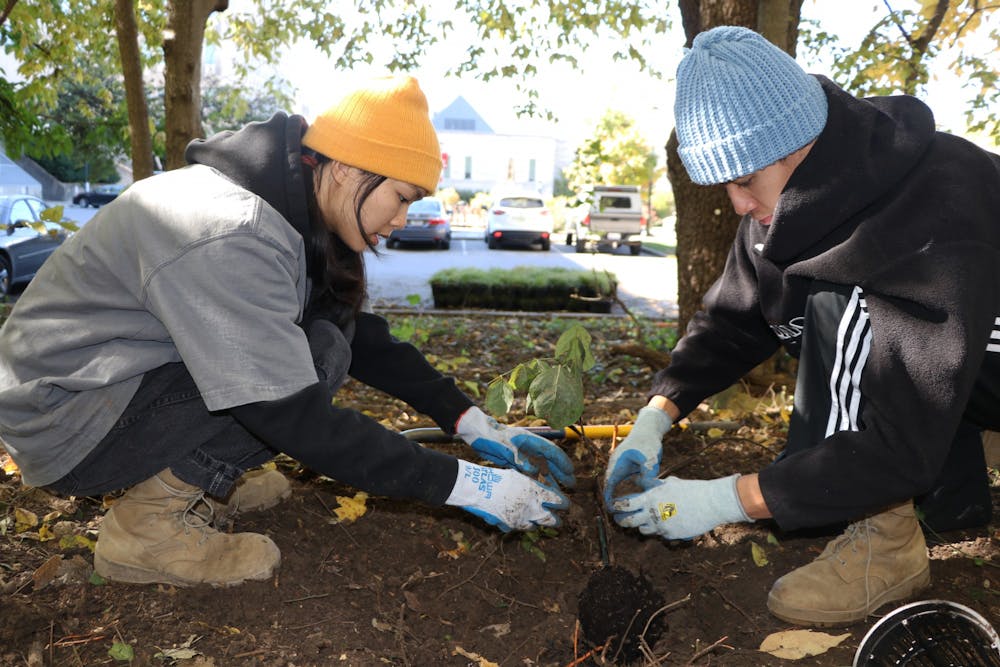IU students, faculty and community members planted native trees in a little-known part of IU’s campus Saturday afternoon in an effort to restore forest ecosystems on campus.
Attendees planted 38 native trees Saturday, O’Neill School professor Jon Eldon said. Eldon said events like these are an investment in the future.
“You want a nice forest 50 years from now?” he said. “You’ve got to plant trees now, even if you don't see the benefits for decades.”
IU president: Pamela Whitten inaugurated as IU’s 19th, first female president
Almost two dozen volunteers wearing garden gloves and work boots gathered in the forested area tucked behind the O’Neill School building.
“Everybody talks about Dunn Woods but not about woodlots like this one,” Eldon said to attendees, gesturing to the trees behind him. “This woodlot has gotten more attention in the past two weeks than in the last 100 years.”
The week prior on Oct. 30 Eldon helped lead an invasive species removal event at the same location. Volunteers returned to the woodlot Saturday for the second part of Sustain IU’s “A Resilient Woodland Campus” event series.
Saturday’s event, sponsored by the College of Arts and Science’s 2021 Themester theme of “Resilience”, aimed to improve the health of IU’s campus woodlots by planting native tree species. Eldon said campus woodlots — patches of small wooded areas scattered throughout campus — are a critical yet often overlooked piece of IU’s campus ecosystem.
“People make use of Dunn Woods every day, but we've got 10 or 20 Dunn Woods on campus,” he said. “We just don't don't recognize the other ones.”
Campus woodlots haven’t been actively managed in generations, Eldon said. They’ve been overtaken by invasive species, like bush honeysuckle, and are now dominated by maple trees, which despite their vivid fall colors, don’t provide the same benefits as other native species like oak, hickory, black gum and yellowwood.
Improving campus woodlots is crucial to ensuring a future healthy campus, Eldon said. Woodlots can help mitigate climate impacts by absorbing heat, aiding stormwater runoff, reducing erosion, storing carbon and providing wildlife habitat.
Eldon said students have driven recent efforts to conserve woodlots, including a class project surveying the health of campus woodlots in 2019. Student involvement is especially important as IU Landscape Services is dramatically understaffed due to COVID-19 and doesn’t have the resources to extend to woodlots, he said.
IU greek life: Fraternity parties, paired events canceled indefinitely
Hannah Gregory, an IU graduate who led the 2019 Indiana University Bloomington Tree Inventory and now leads the Canopy Bloomington project, said she was encouraged to see IU students help plant nearly 40 trees in one afternoon.
“By students taking initiative and reaching out to Landscape Services or professors that can get them involved in urban forestry on campus, they can really make a big difference,” Gregory said.
IU sophomore Cooper Sykes said he grew closer to IU’s campus Saturday by getting his hands dirty while planting a sapling.
“As a part of the Bloomington community, we're collectively responsible to create a sustainable campus,” he said. “Part of the way you build that relationship is learning about the woodlots that people have never really thought about before because just as each individual student matters, every individual tree here on campus has a purpose.”
Eldon said three times more attendees than expected came to Saturday’s tree planting event. He said he’s hopeful for the future of campus woodlots after witnessing students like Sykes eager to spend their weekend shoveling dirt and pulling out invasive vines.
“There's a lot of work to be done, but even just what I'm seeing now is really exciting,” he said. “Knowing there's this level of interest from students, let's ramp it up in the spring. Let's plant a thousand trees.”




